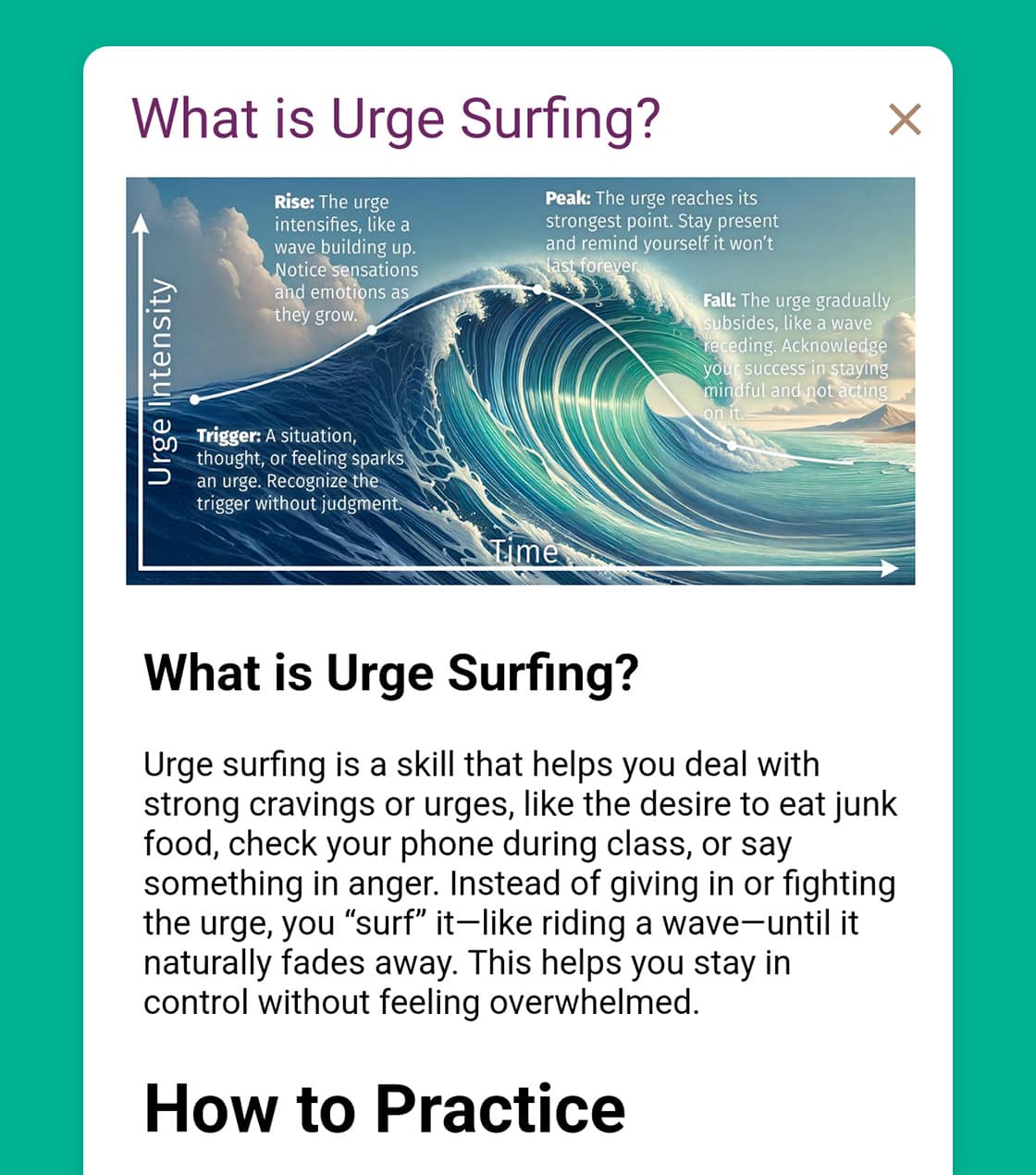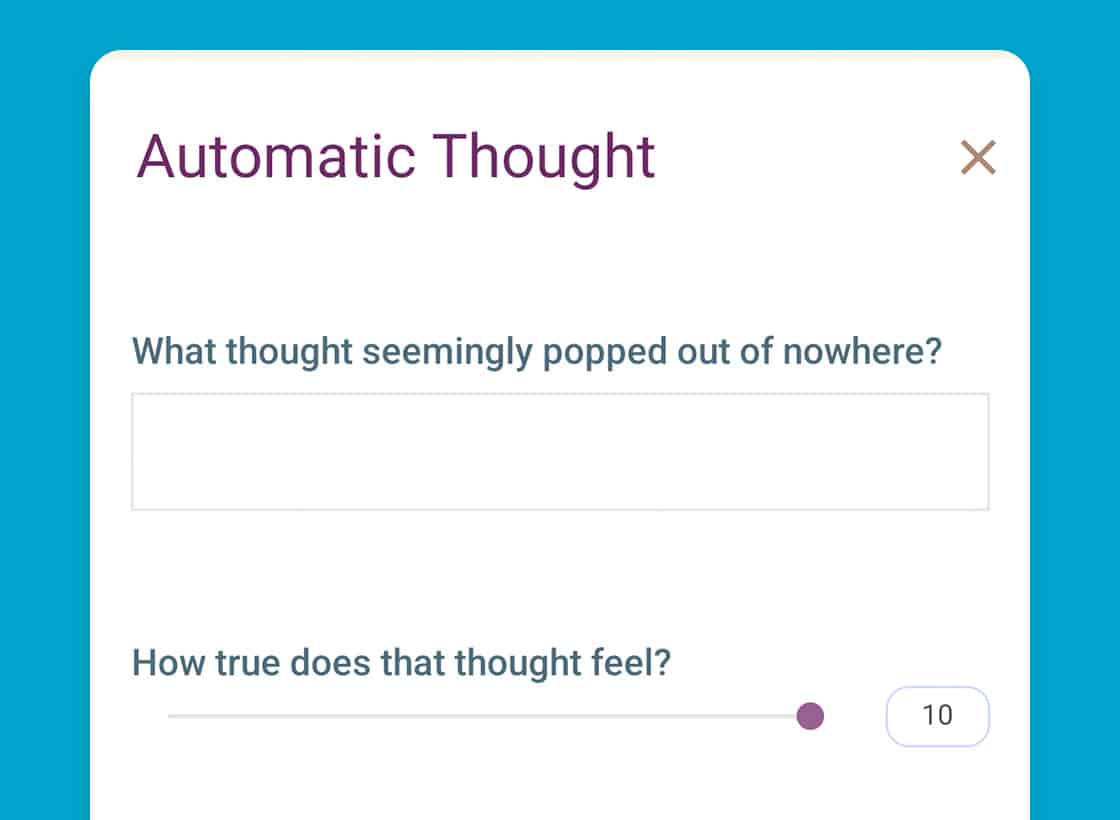What is Urge Surfing?
Template by Reflective
Best for DBT ACT Solution Focused Substance Use
The What is Urge Surfing? Infosheet introduces clients to a mindfulness-based technique designed to help manage cravings and impulses by observing and “riding the wave” of urges without acting on them. Rooted in Mindfulness-Based Relapse Prevention (MBRP) and often integrated into Acceptance and Commitment Therapy (ACT) and Dialectical Behavior Therapy (DBT), this approach is particularly effective for clients working through substance use, eating disorders, and other addictive behaviors. The infosheet provides a clear explanation of the technique and its benefits, empowering clients to develop greater self-awareness, emotional regulation, and long-term coping strategies.
Share What is Urge Surfing? with your client
Share What is Urge Surfing? with your client using the Reflective app so they can reference it between sessions. Simply enter their email, and they’ll be able to fill in the worksheet from the convenience of their phone. Sign up for a Free trial.
How does Reflective work?
Share exercise with client via Reflective
Client receives email with app link and connection request
Client clicks link to download app
Client accepts your connection and exercises you shared
Client uses app to fill in exercises, gets reminders
Table of Contents
- Introduction
- History of the Urge Surfing Technique
- The Science Behind Urge Surfing
- Teaching Urge Surfing to Clients
- Reflective in Practice: Reinforcing Urge Surfing Between Sessions
- Case Examples and Success Stories
- Closing Thoughts
Helping Clients Ride the Wave Instead of Fighting the Tide
Urge surfing is a mindfulness-based technique that empowers clients to navigate intense urges—such as cravings, impulsive desires, or overwhelming emotions—by observing them without acting on them. This skill is particularly effective for clients managing addiction, emotional dysregulation, or impulsivity. Rather than resisting urges (which can intensify them), clients learn to accept and ride out the wave, allowing the urge to naturally subside.
Therapists who integrate urge surfing into their practice can enhance client outcomes in a variety of therapeutic modalities, including Dialectical Behavior Therapy (DBT) and Acceptance and Commitment Therapy (ACT). Tools like Reflective can further strengthen skill acquisition by keeping clients engaged and accountable between sessions.
History of Urge Surfing
Urge surfing originated from the integration of mindfulness techniques into addiction recovery frameworks. Dr. Alan Marlatt, a pioneering researcher in addiction and relapse prevention, developed the concept in the 1990s. Inspired by the mindfulness-based practices popularized by Jon Kabat-Zinn’s Mindfulness-Based Stress Reduction (MBSR) program in the late 1970s, Marlatt applied these principles to help individuals manage cravings and avoid relapse.
Marlatt’s approach, called Mindfulness-Based Relapse Prevention (MBRP), emphasized the importance of observing urges with nonjudgmental awareness. He introduced the wave metaphor to illustrate how urges naturally rise and fall, helping clients recognize that discomfort is temporary and does not require immediate action. This technique has since been widely adopted in therapies such as Dialectical Behavior Therapy (DBT) and Acceptance and Commitment Therapy (ACT), where mindfulness and distress tolerance play key roles.
Key sources for this work include:
- Marlatt, G. A., & Donovan, D. M. (2005). Relapse Prevention: Maintenance Strategies in the Treatment of Addictive Behaviors. The Guilford Press.
- Kabat-Zinn, J. (1990). Full Catastrophe Living: Using the Wisdom of Your Body and Mind to Face Stress, Pain, and Illness. Bantam Books.
- Bowen, S., Chawla, N., & Marlatt, G. A. (2011). Mindfulness-Based Relapse Prevention for Addictive Behaviors: A Clinician’s Guide. The Guilford Press.
Therapists who integrate urge surfing into their practice can enhance client outcomes in a variety of therapeutic modalities, including Dialectical Behavior Therapy (DBT) and Acceptance and Commitment Therapy (ACT). Tools like Reflective can further strengthen skill acquisition by keeping clients engaged and accountable between sessions.
Teaching Urge Surfing to Clients
To help clients master urge surfing, therapists can follow these steps:
- Recognize the Urge Encourage clients to notice the urge as soon as it arises. Awareness is the first step to breaking automatic reactions.
- Name and Describe the Urge Guide clients to describe their experience in detail, including physical sensations (e.g., tightness in the chest) and emotional components (e.g., anxiety or frustration).
- Practice Mindful Breathing Teach clients to use their breath as an anchor to stay present. Slow, deep breathing can help them remain calm and grounded.
- Visualize the Urge as a Wave Clients imagine the urge rising, peaking, and eventually falling, much like a wave. This visualization reinforces the impermanence of their discomfort.
- Allow the Wave to Pass Encourage clients to sit with the urge, observing it without acting on it. Reassure them that even strong urges will fade with time.
Common challenges include clients catastrophizing their discomfort or struggling to maintain mindfulness. Therapists can address these by normalizing the difficulty of the practice and offering compassionate encouragement.
Urge Surfing Between Sessions
Reflective’s tools can amplify the effectiveness of urge surfing by fostering ongoing practice and accountability. Key features include:
- Meditations: Check out the urge surfing script and guided meditation exercises which can be added to your client’s weekly practice between sessions.
- Client Reminders: Reflective can send reminders to practice urge surfing during high-risk moments, such as after a stressful day.
- Journaling Prompts: Clients can log their experiences, noticing patterns and triggers associated with their urges. For example, prompts might include:
- “Describe a recent situation where you felt an urge. What happened when you observed it like a wave?”
- “Rate the intensity of your urges over the past week and how successfully you surfed them.”
- Progress Tracking: Therapists can review clients’ entries to identify trends and provide tailored feedback, helping clients refine their technique.
By bridging the gap between sessions, Reflective ensures that urge-surfing practice becomes an integrated part of clients’ daily lives.
Case Examples and Success Stories
Client A: Controlling Anger Outbursts
Client A struggled with frequent urges to lash out during conflicts. By practicing urge surfing, they developed the ability to pause and observe their anger as a wave, focusing on physical sensations such as muscle tension or heat in the body. This mindfulness practice allowed them to delay impulsive reactions, leading to more constructive communication. Reflective can enable Client A to journal about triggering events and monitor patterns, allowing their therapist to monitor and provide tailored interventions.
Client B: Alcohol Use
Client B faced strong urges to consume alcohol after stressful workdays. With urge surfing mindfulness practice, they learned to observe their cravings without immediately acting on them. By recognizing the physical sensations (e.g., a dry mouth or restlessness) and visualizing the urge as a wave, they gained the ability to sit with their discomfort. Reflective can support Client B by offering a platform to meditate along with the urge surfing audio guide, journal their triggers and reflect on moments of success, enabling their therapist to help them identify high-risk situations and develop alternative coping strategies.
These examples highlight how urge surfing, supported by Reflective, can empower clients to navigate even the most challenging urges.
Conclusion
Urge surfing is a skill that therapists can use to help clients manage impulses and emotions. By teaching clients to “ride the wave,” therapists equip them with a lifelong tool for resilience and self-regulation.
Reflective complements this work by extending therapeutic support beyond the session, helping clients practice and refine their skills in real time. To see how Reflective can elevate your practice and enhance client engagement, start using it with your clients today.



